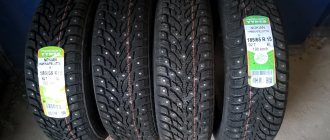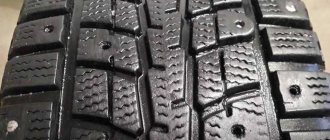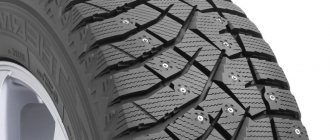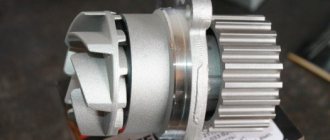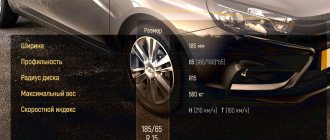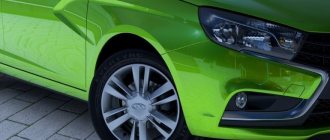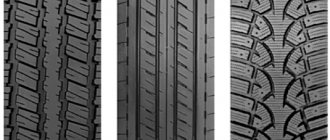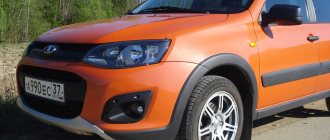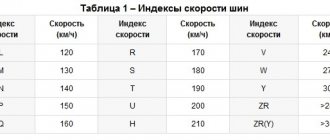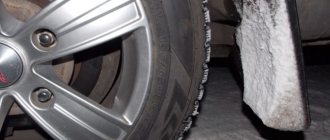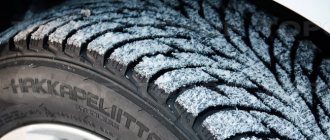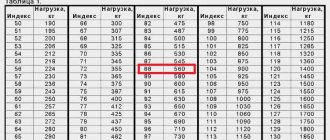It is better to take care of choosing winter tires in the summer, when prices have not yet risen. Deciding on a tire brand is not easy, because every tire manufacturer claims that its products are the best. Let's look at several tests of winter tires and, based on the ratings, try to determine the best studded model in terms of price/quality ratio.
Review of winter tires from Autoreview
At the end of 2015, the online publication Autoreview tested 11 sets of winter tires with a dimension of 205/55 R16 at a snow test site. The test results were published in the following table:
| Options | Impact on Overall Score | Continental | Cordiant | Dunlop | Gislaved | Goodyear | Hankook | Maxxis | Nokian | Nordman | Pirelli | Toyo |
| Ice | 40% | |||||||||||
| Braking properties | 15% | 9 | 8 | 8 | 7 | 9 | 9 | 7 | 10 | 7 | 9 | 7 |
| Accelerating dynamics | 10% | 9 | 9 | 8 | 7 | 9 | 9 | 7 | 10 | 8 | 9 | 7 |
| Transverse adhesion properties | 5% | 10 | 8 | 9 | 9 | 9 | 9 | 8 | 10 | 9 | 9 | 8 |
| Handling (lap time) | 5% | 10 | 8 | 8 | 8 | 9 | 8 | 7 | 10 | 9 | 8 | 6 |
| Control reliability | 5% | 9 | 8 | 8 | 8 | 8 | 8 | 9 | 9 | 10 | 9 | 7 |
| Snow | 25% | |||||||||||
| Braking properties | 10% | 9 | 10 | 9 | 7 | 10 | 9 | 7 | 10 | 8 | 8 | 7 |
| Accelerating dynamics | 5% | 9 | 10 | 9 | 8 | 9 | 9 | 7 | 9 | 8 | 9 | 8 |
| Handling (lap time) | 5% | 8 | 10 | 7 | 7 | 7 | 9 | 5 | 8 | 6 | 7 | 4 |
| Control reliability | 5% | 10 | 10 | 8 | 8 | 9 | 9 | 8 | 10 | 9 | 9 | 7 |
| Patency | 10% | 8 | 7 | 7 | 8 | 9 | 9 | 9 | 8 | 9 | 10 | 8 |
| Wet asphalt | 10% | |||||||||||
| Braking properties | 10% | 9 | 7 | 9 | 10 | 9 | 9 | 9 | 9 | 9 | 9 | 8 |
| Dry asphalt | 5% | |||||||||||
| Braking properties | 5% | 8 | 6 | 8 | 8 | 8 | 6 | 7 | 7 | 6 | 8 | 6 |
| Comfort | 10% | |||||||||||
| Acoustic comfort | 5% | 5 | 6 | 6 | 7 | 5 | 5 | 5 | 4 | 5 | 4 | 6 |
| Smooth ride | 5% | 9 | 8 | 8 | 8 | 8 | 7 | 7 | 8 | 8 | 8 | 8 |
| Overall rating | 100% | 8,75 | 8,20 | 8,05 | 7,80 | 8,65 | 8,45 | 7,40 | 8,95 | 7,95 | 8,50 | 7,05 |
Explanation of the models in the rating “ best winter tires with studs ”:
- Nokian Hakkapeliitta 8
- Continental IceContact 2
- Goodyear UltraGrip Ice Arctic
- Pirelli Ice Zero
- Hankook Winter i*Pike RS Plus
- Cordiant Snow Cross
- Dunlop Ice Touch
- Nokian Nordman 5
- Gislaved Nord*Frost 100
- Maxxis Arctictrekker NP3
- Toyo Observe G3-Ice
In addition to the grip properties of tires on different surfaces, car owners are concerned about acoustic comfort. Based on these requests, a rating of “ the quietest studded tires ” was compiled:
- Gislaved Nord*Frost 100
- Cordiant Snow Cross, Dunlop Ice Touch, Toyo Observe G3-ice
- Continental Icecontact 2, Goodyear Ultragrip Ice Arctic, Hankook Winter i*pike RS Plus, Maxxis Arctictrekker NP3, Nokian Nordman 5
- Nokian Hakkapeliitta 8, Pirelli Zero
What to look for when choosing winter tires
In addition to the main two differences (studded/non-studded), winter tires have many additional criteria that you need to rely on when selecting tires:
1. The size and type suitable for your vehicle are recorded in the service book. If you don't have it, you can look up the car's specifications on the Internet.
2. The date of manufacture of tires should not exceed three years. It is written on the side of the tire in the form of 4 numbers. The first pair represents the week, the second pair represents the year.
3. The reinforced frame is marked XL. This type of rubber is more durable and has a greater load capacity. These same tires are best used on SUVs.
4. The noise level from studded wheels is several times higher than from Velcro wheels. Velcro can be installed without fear in the off-season, when the weather is unclear.
5. Winter tires have their own type of tread - it has more sipes at different angles, which improves the grip properties of the wheel. The rubber itself is softer than summer tires, so it doesn’t harden in the cold.
6. Various manufacturers are developing innovative technologies that improve the technical characteristics of tires.
The cost of winter tires is determined by many factors, not the least of which is the reputation of the manufacturer. But in any case, you can find excellent options on the market for any budget.
Winter tire rating from ZaRulem
At the end of 2015, another well-known publication, ZaRulem, presented its results of tests of studded tires to the general public. In total, 11 sets of R14 tires took part in the tests.
In this test, the quietest winter tires are:
- Nokian Hakkapeliitta 8
- Continental Contiecocontact 2
- Nokian Nordman 5
Based on the data presented, you can make a rating of winter tires in terms of price/quality ratio :
| Place | Model | Price, r | Place in Autoreview tests | Place in ZaRulem tests |
| 1 | Avatyre Freeze | 1770 | 10 | |
| 2 | Cordiant Snow Cross | 2000 | 6 | 9 |
| 3 | Pirelli Formula Ice | 2140 | 4 | |
| 4 | Sava Eskimo Stud | 2135 | 5 | |
| 5 | Aeolus Ice Challenger | 2140 | 11 | |
| 6 | Toyo Observe G3-Ice | 2310 | 11 | 8 |
| 7 | Nokian Nordman 5 | 2415 | 8 | 3 |
| 8 | Yokohama Ice Guard IG55 | 2590 | 7 | |
| 9 | Bridgestone Blizzak Spike-01 | 2960 | 6 | |
| 10 | Nokian Hakkapeliitta 8 | 3960 | 1 | 1 |
| 11 | Continental Contiecocontact 2 | 3940 | 1 |
Now, based on the data presented, it will be much easier to make the right choice. We have highlighted the TOP 3 in price/quality ratio.
Spikes or Velcro - which winter tires are better?
When choosing tires for the winter, keep in mind that the difference between studded and friction models is in the studs, the composition of the rubber compound, the number and size of sipes, and the tread pattern.
Therefore, it is wrong to think that studded tires are “Velcro” that has been studded. It follows that if the rubber has lost most of its studs, it cannot be considered “Velcro”, since the models have different compositions and tread patterns. Let's take a closer look at each type of tire:
Studded tires for winter
Equipped with metal studs, suitable for driving on icy roads, guaranteeing optimal grip on any surface. It is effective on snowy surfaces and has a minimal braking distance. Today, the best manufacturers make front-wheel drive models and assemble kits for all-wheel drive and rear-wheel drive cars. Thanks to its elasticity and pattern, the tread holds the road confidently and does not wear out under heavy loads.
Before choosing tires, you need to decide which studs will suit your driving style, and which pattern will provide good cross-country ability under operating conditions. Metal cutters installed in the winter tire tread provide traction on loose snow and dry ice. Therefore, such kits are suitable for car enthusiasts who live out of town or regularly travel to the region.
Velcro friction tires
The selected type of tire is not equipped with studs, but is suitable for use in winter. The properties of the composition allow the use of Velcro at low temperatures. Even during severe frosts, the base of the tire does not lose its elasticity. The best models have a fairly rigid base, soft and rounded side blocks. They provide good maneuverability on wet winter roads, minimal braking distance, and are suitable for Moscow and the region.
The presence of pronounced lamellas on the surface allows the Velcro to literally stick to an icy road or compacted snow. The model has channels for draining water, so hydroplaning is impossible if you drive carefully. Friction tires differ from rubber with studs in properties that allow you to comfortably operate your car at zero temperatures.
Reviews and tests of tires 2017-2018
Show/Hide text
Identical tires in different tests are marked with the same color. Autoreview
conducted a test of 14 models of studded tires size 215/65 R16. The results are presented in the table (link to the test under the video):
| № | Name | Price, r | Points |
| 1 | Nokian hakkapeliitta 9 suv | 7800 | 8.8 |
| 2 | Gislaved nord frost 200 | 4850 | 8.35 |
| 3 | Hankook winter i*pike rs plus | 4750 | 8.35 |
| 4 | Pirelli ice zero | 5150 | 8.35 |
| 5 | Cordiant snow cross | 3700 | 8.15 |
| 6 | Nokian nordman 7 suv | 5050 | 8.15 |
| 7 | Goodyear ultragrip ice arctic | 4900 | 8.1 |
| 8 | Michelin x-ice north 3 | 5150 | 7.8 |
| 9 | Bfgoodrich g-force stud | 4350 | 7.75 |
| 10 | Formula ice | 4500 | 7.7 |
| 11 | Toyo observe g3-ice | 4500 | 7.7 |
| 12 | Viatti bosco nordico v-523 | 3900 | 7.35 |
| 13 | Yokohama ice guard ig55 | 4500 | 7.0 |
| 14 | Nexen winguard winspike wh62 | 4200 | 6.9 |
Behind the wheel
conducted a test of 11 models of studded tires 185/65 R15 for budget cars (link to test).
| № | Name | Points |
| 1 | Nokian Hakkapeliitta 9 | 936 |
| 2 | Continental IceContact 2 | 914 |
| 3 | Goodyear UltraGrip Ice Arctic | 898 |
| 4 | Nordman 7 | 888 |
| 5 | Cordiant Snow Cross (PW-2) | 871 |
| 6 | Dunlop SP Winter Ice 02 | 852 |
| 7-8 | Nitto Therma Spike (NTSPK-B02) | 847 |
| 7-8 | Toyo Observe G3-Ice (OBG3S-B02) | 847 |
| 9-10 | Formula Ice | 841 |
| 9-10 | Gislaved Nord Frost 200 | 841 |
| 11 | Kumho WinterCraft Ice (Wi31) | 803 |
Auto.mail.ru
tested 8 studded tires. The rating is as follows:
- Nokian Hakkapeliitta 9
— 4800 rubles - Pirelli Ice Zero
— 3400 rubles - Nokian Nordman 7
— 3300 rubles - Michelin X-ice North 3
— 3600 rubles - Gislaved Nord Frost 200
- 3200 rubles - Bridgestone Blizzak SP-02 — 3600 rubles
- Hankook Winter i'Pike RS
— 3200 rubles - Yokohama iceGuard Stud iG55
— 3200 rubles
NH9 - Nokian Hakkapeliitta 9, PIZ - Pirelli Ice Zero, NN7 - Nokian Nordman 7, MXIN3 - Michelin X-Ice North 3, GNF200 - Gislaved Nord Frost 200, BBS02 - Bridgestone Blizzak Spike-02, HWi'PRS - Hankook Winter i' Pike RS, YiG55 – Yokohama iceGuard Stud iG55
| Weight Factor | NH9 | PIZ | NN7 | MXIN3 | GNF200 | BBS02 | HWi'PRS | YiG55 | |
| Ice | |||||||||
| Braking | 0,15 | 100,0 | 78,4 | 80,8 | 79,8 | 76,1 | 81,1 | 64,7 | 51,3 |
| Overclocking | 0,05 | 100,0 | 93,6 | 96,9 | 87,7 | 86,4 | 100,0 | 79,6 | 61,3 |
| Total grip properties (lap time) | 0,05 | 100,0 | 68,1 | 65,6 | 63,3 | 55,3 | 50,3 | 58,5 | 52,4 |
| Transverse clutch | 0,05 | 100,0 | 91,3 | 88,6 | 91,7 | 82,3 | 80,5 | 83,0 | 78,6 |
| Ice stability | 0,05 | 100 | 90 | 90 | 70 | 60 | 80 | 60 | 60 |
| Total ice | 0,35 | 35,00 | 28,91 | 29,17 | 27,61 | 25,62 | 27,70 | 23,76 | 20,31 |
| Snow | |||||||||
| Braking | 0,1 | 98,7 | 99,0 | 98,9 | 100,0 | 99,1 | 98,5 | 97,7 | 96,1 |
| Overclocking | 0,03 | 98,3 | 100,0 | 98,5 | 94,5 | 99,2 | 96,9 | 95,6 | 96,7 |
| Total grip properties (lap time) | 0,05 | 97,4 | 100,0 | 96,0 | 96,2 | 97,3 | 90,5 | 92,9 | 90,8 |
| Snow stability | 0,03 | 100,0 | 95,0 | 90,0 | 75,0 | 65,0 | 70,0 | 60,0 | 55,0 |
| Skid resistance | 0,02 | 100,0 | 100,0 | 90,0 | 95,0 | 70,0 | 75,0 | 80,0 | 65,0 |
| Patency | 0,02 | 80,6 | 77,8 | 90,7 | 100,0 | 80,1 | 80,3 | 78,3 | 82,5 |
| Total snow | 0,25 | 24,30 | 24,31 | 23,97 | 23,80 | 22,71 | 22,49 | 22,24 | 21,77 |
| Wet asphalt | |||||||||
| Braking | 0,12 | 100,0 | 96,6 | 92,1 | 94,8 | 99,0 | 91,9 | 95,5 | 91,1 |
| Total grip properties (lap time) | 0,05 | 100,0 | 98,8 | 99,0 | 98,2 | 99,7 | 97,9 | 98,6 | 97,6 |
| Stability on wet asphalt | 0,04 | 100,0 | 95,0 | 90,0 | 80,0 | 90,0 | 70,0 | 90,0 | 80,0 |
| Total wet asphalt | 0,21 | 21,00 | 20,33 | 19,61 | 19,49 | 20,46 | 18,72 | 19,99 | 19,02 |
| Dry asphalt | |||||||||
| Braking | 0,1 | 99,3 | 98,9 | 94,7 | 96,1 | 95,7 | 95,0 | 95,0 | 100,0 |
| Total dry asphalt | 0,1 | 9,93 | 9,89 | 9,47 | 9,61 | 9,57 | 9,50 | 9,50 | 10,00 |
| Effort to pull out the spikes | 55,7 | 75,0 | 65,9 | 58,5 | 45,8 | 100,0 | 61,7 | 78,8 | |
| Effort to pull out the spikes | 0,02 | 1,11 | 1,50 | 1,32 | 1,17 | 0,92 | 2,00 | 1,23 | 1,58 |
| Smooth ride | 80 | 75 | 85 | 100 | 85 | 70 | 85 | 60 | |
| Smooth ride | 0,03 | 2,4 | 2,25 | 2,55 | 3 | 2,55 | 2,1 | 2,55 | 1,8 |
| Acoustic comfort | 50 | 45 | 65 | 85 | 95 | 50 | 100 | 65 | |
| Acoustic comfort | 0,04 | 2 | 1,8 | 2,6 | 3,4 | 3,8 | 2 | 4 | 2,6 |
| Total | 1,000 | 95,75 | 88,98 | 88,68 | 88,07 | 85,62 | 84,52 | 83,27 | 77,08 |
| Place in the test | 1 | 2 | 3 | 4 | 5 | 6 | 7 | 8 | |
Studs for Vesta and Solaris: test of good winter tires
Final rating
:
| Name | Price, r | Autoreview | Behind the wheel | Auto.mail.ru | Average value |
| Nokian Hakkapeliitta 9 | 7800 | 1 | 1 | 1 | 1 |
| Gislaved Nord Frost 200 | 4850 | 2 | 9-10 | 5 | 5,5 |
| Hankook Winter I*Pike RS plus | 4750 | 3 | 7 | 5 | |
| Pirelli Ice Zero | 5150 | 4 | 2 | 3 | |
| Cordiant Snow Cross | 3700 | 5 | 5 | 5 | |
| Nokian Nordman 7 | 5050 | 6 | 4 | 3 | 4,3 |
| Goodyear Ultragrip Ice Arctic | 4900 | 7 | 3 | 5 | |
| Michelin X-Ice North 3 | 5150 | 8 | 4 | 6 | |
| Bfgoodrich G-force Stud | 4350 | 9 | 9 | ||
| Formula Ice | 4500 | 10 | 9-10 | 9,75 | |
| Toyo Observe G3-ice | 4500 | 11 | 7-8 | 9,25 | |
| Viatti Bosco Nordico v-523 | 3900 | 12 | 12 | ||
| Yokohama Ice Guard IG55 | 4500 | 13 | 8 | 10,5 | |
| Nexen Winguard Winspike WH62 | 4200 | 14 | 14 | ||
| Continental IceContact 2 | 3600 | 2 | 2 | ||
| Dunlop SP Winter Ice 02 | 2600 | 6 | 6 | ||
| Nitto Therma Spike (NTSPK-B02) | 2600 | 7-8 | 7,5 | ||
| Kumho WinterCraft Ice (Wi31) | 2800 | 11 | 11 | ||
| Bridgestone Blizzak SP-02 | 3600 | 6 | 6 |
Difference in behavior on the road
The different operating principles of studs and friction tires cannot but affect their properties. At the same time, both types of rubber behave differently depending on what is under the wheels and the surface temperature. Tests conducted by the Autoreview publication in 2013 and 2022, and by the Finnish magazine Tekniikan Maailma in 2013 will help you visually compare the behavior of studded and non-studded tires.
On ice
During tire tests in 2013, journalists rode on ice at temperatures of –14–17 °C. Tires of different price categories were tested: from premium Continental to Russian Kama Euro-519. Under these conditions, when braking from 25 to 5 km/h, the studs showed results from 10.4 to 13.5 m; the friction clutches required from 12.6 to 16.2 meters for the same deceleration.
In 2022, the situation has not changed much. The tires were checked by braking from 20 to 0 km/h. Most of the studs helped the car stop in 7-8.2 meters. Velcro provided a braking distance of 8.2-9.2 meters. But some budget studded tires brake even worse; with them the car stopped in 8.7-10.5 meters. Grip while driving is measured by the time spent either accelerating to a certain speed or completing a given route. According to the results of the 2013 test, the Velcro took from 6.3 to 8.8 seconds to accelerate from 5 to 25 km/h, while the studs completed this task in 4-5.5 seconds, that is, almost twice as fast.
The car covered the ice ring on friction tires in 34.3-38.3 seconds, and on studded tires in 25.8-29.8 seconds. A test on a winding icy track revealed similar results: the studs with the worst performance of 88.3 seconds were 7.7 faster than the fastest velcro.
In 2022, friction tires look better in similar conditions, but also lag behind top-end studded tires. The result of the Velcro circle ranges from 98.2 to 105.2 seconds, while on the spikes the car goes through the same configuration in 90-114.0 seconds.
Do you want to find out how two identical Jaguar XEs with top-end Continental studs and Velcro behave and listen to a comment from a specialist from the tire concern? Then watch the video:
On snow
On snowy surfaces the situation is opposite. For example, in 2013, Velcro on compacted snow slowed down from 50 to 5 km/h in 25.3–26.8 m, and studs in 25.9–28.4 m, that is, the friction model showed the best result. In 2022, when stopping from 40 km/h, Velcro ensured a stop in 17.4–17.9 m, and studded tires in 17.2–18.6 m.
In terms of acceleration time and passing a snowy track, Velcro are also in the lead: a car with friction tires drove a given configuration in 90.7-96.3 seconds, with studded tires the testers showed the result in 91.8-99.2 seconds.
In the 2022 test, the best studded tires beat the friction tires (minimum time 73 vs. 73.3 seconds), but the weakest studded tires were slower by 4.5 seconds: 82.5 vs. 78 seconds.
Behavior in “snow porridge” deserves special consideration. In the 2013 test, tires were evaluated by the speed at which controllability was lost in slush of snow and water. With friction clutches, the car was stable at speeds up to 22.6-26.9 km/h, and studs lasted up to 19.4-21.2 km/h.
On wet asphalt
Asphalt without snow is a common occurrence in cities even in central Russia. Contrary to the popular belief that studs slide on the asphalt, back in 2013, studs generally performed better: on them, the braking distance of a car when stopping from 80 km/h was 35.11–38.7 m, while a car with Velcro required braking 33.1-41.1 meters.
In a similar test of the 2022 test, the studs increased their superiority, showing a result of 29.8-33.6 meters versus 30.9-37.1 meters for Velcro.
On dry asphalt
The “Rearrangement” maneuver, performed during the 2013 test, showed a slight advantage of friction rubber: the test could be completed on it at a maximum speed of 59.7–63.7 km/h, and the studs made it possible to complete the task at a speed of 60–62.4 km/h
Reviews and tests of tires 2018-2019
Show/Hide text
1. Driving
.
Test No. 1: The magazine's experts collected six sets of 15-inch tires from Western and Eastern manufacturers, size 195/65 R15. Link to tests.
Test No. 2: We tested popular “studs” for small crossovers (dimension 215/65 R16).
| № | Model | Price, r | Point |
| 1 | Nokian Hakkapeliitta 9 SUV | 7590 | 927 |
| 2 | Continental IceContact 2 SUV | 6220 | 908 |
| 3 | Yokohama iceGUARD iG65 | 4880 | 902 |
| 4 | Gislaved Nord*Frost 200 SUV | 5170 | 888 |
| 5-6 | Goodyear UltraGrip Ice Arctic | 5180 | 879 |
| 5-6 | Nordman 7 SUV | 5260 | 879 |
| 7 | Michelin X-Ice North 3 | 5430 | 864 |
| 8 | Nexen Winguard WinSpike WH62 | 4200 | 796 |
2. Autoreview
. On the tracks of the Swedish Arctic Falls test site we had to test 22 sets of winter tires, but in the final protocol 21 models of size 205/55 R16 remained.
| № | Model | Price, r | Point |
| 1 | Nokian Hakkapeliitta 9 | 8 000 | 8,95 |
| 2 | Continental IceContact 2 | 6 200 | 8,90 |
| 3 | Gislaved Nord Frost 200 | 4 700 | 8,75 |
| 4 | Nokian Nordman 7 | 4 850 | 8,40 |
| 5 | Goodyear Ultragrip Ice Arctic | 5 100 | 8,35 |
| 6 | Toyo Observe Ice-Freezer | 4 500 | 7,20 |
| 7 | Firestone Ice Cruiser 7 | 4 300 | 7,05 |
| 8 | GT Radial IcePro 3 | 4 150 | 6,45 |
3. Survey.
The TOP 5 brands of winter tires were determined as part of the new study “AUTOSTAT OMNIBUS – 2022.” More than 3 thousand car owners participated in the survey. When forming the sample, quotas were taken into account by gender (no more than 25% of female car owners), as well as by the characteristics of “vehicle age” and “geography of respondents’ residence.”
- "KAMA" (10.6%),
- Cordiant (10.4%),
- Bridgestone (10.3%),
- Nokian Tires (10.1%),
- Michelin (8.9%).
In general, these 5 brands accounted for half of the questionnaires from the total sample.
Final table
:
| Model | Price, r | AR position | Position “Behind the Wheel” No. 1 | Position “Behind the Wheel” No. 2 |
| Nokian Hakkapeliitta 9 | 8 000 | 1 | 1 | 1 |
| Continental IceContact 2 | 6 200 | 2 | 2-3 | 2 |
| Gislaved Nord Frost 200 | 4 700 | 3 | 7 | 4 |
| Nokian Nordman 7 | 4 850 | 4 | 6 | 5-6 |
| Goodyear Ultragrip Ice Arctic | 5 100 | 5 | 5 | 5-6 |
| Toyo Observe Ice-Freezer | 4 500 | 6 | 9 | — |
| Firestone Ice Cruiser 7 | 4 300 | 7 | 12 | — |
| GT Radial IcePro 3 | 4 150 | 8 | 11 | — |
| Yokohama iceGUARD iG65 | 4 880 | — | — | 3 |
| Michelin X-Ice North 3 | 5 430 | — | — | 7 |
| Nexen Winguard WinSpike WH62 | 4 200 | — | — | 8 |
The best models of winter tires with Velcro
Let's start from the end
Kumho Marshal I'Zen RV Stud KC16
In tenth place, among the sales leaders, are Kumho Marshal I'Zen RV Stud KC16 tires. The company's production is aimed at Western markets, and has a branch in the UK. Even though this brand occupies only tenth place, it is the most common among many car enthusiasts, and leaves many tires far behind.
Continental Conti 4×4 Winter Contact
The non-standard tread pattern allows the Continental Conti 4×4 Winter Contact tires to very effectively clear snow and dirt from sticking to them, thanks to the transverse grooves. Due to the relief pattern of the tire, good stability is ensured. Among the main advantages, it is worth noting the ability to travel on country roads covered with a thick layer of snow or a dense ice crust.
Hankook DynaPro i*cept RW08
In eighth place, quite solidly, is another representative, produced in Korea, which is rapidly conquering markets around the world, these are Hankook DynaPro i*cept RW08 tires. The tires have good grip on icy surfaces and cope well with snow-covered roads. They also have good acoustic properties and a very reasonable price.
Yokohama Geolandar I/TS G073
The seventh line is occupied by Japanese-made tires Yokohama Geolandar I/TS G073. Tests have shown that using these tires you can easily climb a small hill, even if it is covered with a small layer of ice. When making sharp turns or braking, like most Velcro, it tends to slip and make involuntary drifts. Doesn't perform well on ice.
Reviews and tests of tires 2019-2020
Show/Hide text
1.
The magazine "Behind the Wheel" tested tires with dimensions 205/55 R16. Experts note that this has never happened in their tire tests. Fantastic gap between leaders and outsiders. The results were published in the October journal.
| № | Name | Point | Price, r |
| 1 | Michelin X-ice North 4 | 929 | 5760 |
| 2 | Continental Icecontact 3 | 912 | 6260 |
| 3 | Nokian Hakkapeliitta 9 | 907 | 7150 |
| 4 | Hankook Winter i*pike RS2 | 905 | 4840 |
| 5 | Yokohama Ice Guard IG65 | 860 | 4860 |
| 6 | Nordman 7 | 857 | 4890 |
| 7 | Gislaved Nord Frost 200 | 853 | 4890 |
| 8 | Toyo Observe Ice-freezer | 803 | 4550 |
| 9 | Viatti Brina Nordico | 771 | 3650 |
| 10 | Roadstone Winguard Winspike | 755 | 3990 |
| 11 | Tunga Nordway 2 | 723 | 3680 |
| 12 | Sailun Ice Blazer WST3 | 722 | 3390 |
Full comparison table (in PDF):
2.
In the Yandex.Market study, experts used data on user transitions to online stores from January 1 to October 13, 2022.
TOP most popular winter tires:
- Kama-505 175/70 R13 82T
- Nokian Tires Nordman 5 185/65 R15 92T
- Nokian Tires Nordman 5 195/65 R15 95T
- Nokian Tires Nordman 7 185/65 R15 92T
- Michelin X—Ice North 4 185/65 R15 92T
- Nokian Tires Nordman 5 205/55 R16 94T
- Michelin X—Ice North 4 205/55 R16 94T
- Nokian Tires Hakkapeliitta 8 205/55 R16 94T
- Nokian Tires Nordman 5 175/65 R14 86T
TOP 5 best winter studded tires R15
Nokian Tires Nordman 7 195/60 R15 92T
A reliable option for winter, using a sufficient number of polygonal studs.
When in contact with the road surface, the studs are placed vertically, thanks to which it is possible to achieve good traction with snow or ice.
Many users point out the strong noise from winter tires, but this model is not afraid of such a statement.
The manufacturer installed air shock absorption in those blocks where the studs are installed.
The shoulder blocks also deserve special attention.
Drainage grooves placed on them quickly remove ice, water, snow and dirt from the contact patch.
Therefore, the car remains maneuverable even in heavy precipitation, reacts sensitively to steering movements, and installing new tires does not require much effort.
Main characteristics:
- Tire profile width/height - 195/60.
- Using snow or ice spikes, yes.
- Maximum speed is 190 km/h.
- Maximum load - 630 kg.
- Use of run-flat technology - no.
pros
- good braking distance on snow and ice;
- quick control response;
- there are no unexpected surprises around corners.
Minuses
- high noise level.
Bridgestone Ice Cruiser 7000S 195/65 R15 91T
The improved composition of the rubber compound increases the wear resistance of tires under the influence of external factors, and the strong design of the studs with reliable anchors in the thickened tread layer allows for good grip on icy or snowy roads.
In addition, the optimal placement of drainage grooves and the overall tread pattern ensure that the snow slush is held and prevents the wheels from slipping when braking or starting.
The reinforced sidewall features a heavy-duty composite material that improves resistance to impact, cuts and punctures.
This model is perfect for use in areas with bad roads. The tires will last the entire warranty period and will not lose most of their studs in the first season.
Main characteristics:
- Tire profile width/height - 195/65.
- Using snow or ice spikes, yes.
- Maximum speed is 190 km/h.
- Maximum load - 615 kg.
- Use of run-flat technology - no.
pros
- no buzzing from the spikes;
- reinforced sidewalls;
- high level of road grip.
Minuses
- The spikes are short and may not be sufficient when in contact with ice.
GOODYEAR Ultragrip 600 185/65 R15 88T
The model is designed for most modern passenger cars and does not suffer at speeds up to 190 km/h.
The tires can withstand a load of 560 kg, are easy to balance and are responsive to handling.
The shape and placement of the drainage grooves allow you not to worry about the removal of excess moisture during precipitation, the rubber does not slip when braking, and does not slip during a start, even quite sharp.
The model has a reinforced sidewall; upon contact with a deep hole, the development of a hernia is not observed.
Modern composition and quality of materials allow the use of rubber even in areas where the air temperature often drops well below zero. Rubber does not harden, retains its elasticity, does not wear out due to frequent contact with asphalt pavement, and therefore has a long service life.
Main characteristics:
- Tire profile width/height - 185/65.
- Using snow or ice spikes, yes.
- Maximum speed is 190 km/h.
- Maximum load - 560 kg.
- Use of run-flat technology - no.
pros
- the shape of the studs ensures reliability on any surface;
- no slipping in slushy snow;
- fast braking on ice;
- moderate softness, smooth movement.
Minuses
- no directional stability at speeds above 100 km/h.
Pirelli Ice Zero 185/65 R15 92T
Studded tires for passenger cars, characterized by high quality materials used and improved tread pattern.
Due to the latter, stability in control, ease of calibration, excellent directional guidance and grip on any road surface are noted.
The studs are secured very securely and stay in place well even during fairly aggressive driving..
Many users point out the noise of tires on the highway, but within the city the acoustic background remains within normal limits and does not bother the driver.
This model's tread is divided into functional zones; the shoulder zone protects against skidding and provides effective braking.
Main characteristics:
- Tire profile width/height - 185/65.
- Using snow or ice spikes, yes.
- Maximum speed is 190 km/h.
- Maximum load - 630 kg.
- Use of run-flat technology - no.
pros
- do not skid in the snow;
- reliable fastening of spikes;
- quick steering response.
Minuses
- It's very noisy on the highway.
Continental IceContact 3 185/65 R15 92T
Suitable for a wide range of passenger cars, fully fulfills the warranty period and is resistant to wear when in contact with any road surface.
The quality of the rubber and the design of the product itself do not affect the speed of the car and make it easy to drive without loss of maneuverability.
There is a different thickness across the entire sidewall area, so these tires are not afraid of deformation from a deep hole or collision with potholes.
Each stud is placed inside an elastic shell, so there is almost no noise on the road, and road traction is enhanced even on icy roads..
Separately, we note rapeseed oil in the rubber mixture, thanks to which the elasticity of the rubber is maintained at sub-zero temperatures, protecting the tires from cracks.
Main characteristics:
- Tire profile width/height - 185/65.
- Using snow or ice spikes, yes.
- Maximum speed is 190 km/h.
- Maximum load - 630 kg.
- Use of run-flat technology - no.
pros
- excellent tenacity;
- does not steal speed and maneuverability;
- The sidewalls have different thicknesses, which increases stability.
Minuses
- When driving aggressively, the spikes quickly fly out.
Tire reviews and tests 2020-2021
1.
drom.ru focused not on the “tops,” but on those models that, based on the results of comparative tests and driver reviews, have proven themselves to be close to the optimum in price and quality (we are, of course, talking about models for harsh winters).
| Model | Advantages | Flaws |
| Continental Ice Contact 3 | Reliable grip and controllability on slippery surfaces, confident maneuverability. | Deformation and loss of spikes with a rubber body are possible. |
| Cordiant Snow Cross 2 | Good longitudinal traction properties, maneuverability, low price. | Increased noise, possibly unstable workmanship. |
| Dunlop SP Winter Ice 03 | A good balance of grip and handling properties, confident cross-country ability, there is a separate line for SUVs. | |
| Goodyear Ultra Grip Ice Arctic | Reliable longitudinal grip on slippery roads, excellent cross-country ability, there is a line for SUVs. | Low comfort, not the best handling characteristics. |
| Gislaved Nord Frost 200 | Grip properties on ice are average, good maneuverability, comfortable. | Rapid loss of spines is possible. |
| Hankook Winter I*Pike RS2 | Grippy on slippery surfaces, good maneuverability, comfortable, economical. | Sidewalls are not very strong. |
| Michelin X-Ice North 2 | Reliable grip and controllability, excellent cross-country ability, wear resistance. | For this period, there is a limited size range (but the most “popular” versions). |
| Nokian Hakkapeliitta 8 | Good balance of grip on ice and snow, economical, there is a separate line for SUVs. | Noisy, not the most durable stud fastening. |
| Pirelli Ice Zero | Reliable traction and controllability on slippery surfaces, cross-country ability. | Increased noise, not the most durable sidewalls. |
| Sava Eskimo Stud | Good grip and handling on wet and slushy asphalt, economical. | Low comfort, not the most durable stud fit. |
2.
Autoreview has published a rating of 15 sets of winter tires for the 2020/2021 season. Among them are 9 sets of studded ones. This is how the rating came about:
- Michelin X-ice North 4 – 9 points
- Pirelli Scorpion Ice Zero 2 - 8.9 points
- Hankook Winter I*Pike X – 8.75 points
- Nokian Hakkapeliitta 9 SUV – 8.75 points
- Formula Ice - 8.6 points
- Nokian Nordman 7 SUV - 8.15 points
- Gislaved Nord Frost 200 – 7.8 points
- Toyo Observe Ice-Freezer - 7.5 points
- Nokian Nordman 7 used - 6.15 points
Friction tire rating
Continental Viking Contact 7
For three years now, the product of German tire manufacturers has been in first place, demonstrating the optimal combination of characteristics. The model shows good grip on ice and the best speed gains on snowy roads. In loose snow, the Continental is second only to the studded Hankooks, outperforming all other test participants.
Minimum complaints about tires and on wet roads, plus resistance to aquaplaning and minimal noise.
Goodyear UltraGrip Ice SUV
Being one of the new products of the current season, the tires were able to win silver medals in the rating. Of course, the performance on ice is not ideal, but on asphalt in winter they feel excellent, especially in terms of counteracting the effect of aquaplaning and braking. Taking into account the minimal noise level, the new product from Goodyear can be safely recommended to car owners in large cities.
Nokian Hakkapeliitta R3 SUV
On ice, the model is traditionally excellent for Nokian, on snow it is good, but not the best, on asphalt it brakes excellently, but at the same time it behaves worst of all in hydroplaning and is noisy. And all this for a lot of money, reaching 10 thousand rubles per wheel for the tested size (R17).
Taking into account the price tag, the choice in favor of Nokian is not the most reasonable.
Toyo Observe GSi-6
The Japanese tire makers did a good job, so the GSi-6 model was only slightly behind the top three. They work well on an icy surface, but a little worse on a snowy track. The Toyo product also feels good on asphalt, but the rubber’s resistance to aquaplaning is mediocre, which does not allow driving at high speed in heavy rain.
On dry roads, the tires allow you to accelerate to 210 km/h, which is 20-40 km/h more than competitors. At the same time, the price tag of one tire is about 5 thousand rubles, which makes them affordable for most buyers.
Hankook
When driving on ice, rubber exhibits the opposite properties. On the one hand, it has good grip, providing braking and acceleration, but the handling is very mediocre. The behavior is similar in the snow, where good acceleration characteristics are combined with very modest handling.
When driving on asphalt, Hankook tires are average in every sense, but in terms of acoustic comfort they are the test leader.
Nordman RS2 SUV
The characteristics of budget Nordman tires generally fit into the practice of slightly lagging behind the title brand Nokian in terms of characteristics. The lag is primarily noticeable in handling, which is reflected in the lap time (-3 seconds from the Nokian result). However, the car behaves predictably and smoothly, without causing any major problems.
In tests on asphalt, the model showed good resistance to hydroplaning, but was noisy. In general, the choice in favor of the Nordman RS2 SUV is not bad, considering the affordable cost of the kit.
Gislaved Soft*Frost 200
The products of the German brand performed poorly, which was the reason for the last place in the ranking. The grip on ice is weak in both projections. The results are similar on snow, here only the braking is at the level, and the handling is weak. You shouldn’t drive into deep snow on such tires, you might simply not get out.
If in “white” tests the results are mediocre, then on asphalt a rubber compound with high softness behaves very poorly, including in terms of resistance to hydroplaning. Taking into account the minimum price tag among all participants, the result is generally logical.
Tire reviews and tests 2021-2022
1. “Behind the Wheel”
compared eight studs for crossovers with dimensions 205/55 R16. At the same time, we found out which winter tires you can save on when purchasing, without compromising their driving performance.
- Nokian Hakkapeliitta 10p – 929 points
- Michelin X-Ice North 4 - 925 points
- Hankook Winter i*Pike RS2 – 900 points
- Nordman 8 - 890 points
- Formula Ice - 843 points
- Yokohama IceGuard IG65 - 837 points
- Goodyear UltraGrip 600 - 810 points
- Tigar Ice - 807 points
Detailed table with tire tests: To download files you need to log in to the site
What tires do you consider good and of high quality? Leave your reviews and recommendations, and take part in surveys.
How to choose R15 winter tires?
When buying winter tires for your car, pay attention to the following parameters:
- Variety . Winter tires can be studded, friction and all-season. Studded tires are suitable for snowy areas with frequent icy conditions, friction (Velcro) tires are used in low-snow regions, and all-season tires are installed by those who don’t want to spend their budget on a second set. In the latter case, it is worth considering that in winter all-season tires do not have good performance.
- Load and maximum speed . Indicators that reflect the load on each wheel (in kg) and the speed limit when the body is fully loaded (in ideal conditions).
- Check for damage . To do this, run your hand over the tread pattern and evaluate whether you encounter any imperfections. If the palm glides easily, the quality of the product is good.
- To move on a smooth, good surface, choose a pattern with small checkers, and for aggressive movement you need a larger pattern.
- Be sure to check the expiration date . New tires should not be stored in storage for longer than two years.
- Don't skimp on tires if you travel long distances during the season..
Recommendations for choosing winter tires
To wisely choose inexpensive winter tires, remember the following key parameters:
- Softness of the composition
. The more elastic winter tires are, the better they will cling to frozen asphalt. This will also affect the smoothness of driving over bumps, since the fluid in the shock absorbers is denser in winter and they work harder. To increase the elasticity of the compound, manufacturers add increased silica content to it. Since there is no place to read the percentage composition, buyers are left with trying to feel the tires with their fingers. Tires should flex and not feel “plastic.” - Number of slats.
These are additional slots on the blocks, which, upon contact with the road, open up and create numerous edges for engagement. The more there are, the more stable the car’s behavior on the winter road will be. Even in budget tires there can be from 3 to 10 such slots on each block. - Width of grooves
. Water can be effectively drained through narrow grooves, but slush is coarser and needs wide grooves from 3 to 10 mm. The more such elements in the tread pattern, the faster the wheel will be cleared of snow and the denser the contact patch will be. - Lugs
. If you look closely at the shoulder of the tire, you can see ridges at the corners of the transition from the running area to the sidewall. The depth of the grooves between the protrusions varies from 10 to 20 mm. The larger it is, the easier it will be to drive your car out of a rut in winter. - Profile height
. Although the car looks more sporty on low-profile tires of 35-55 mm, for winter it is worth choosing tires with a maximum permissible profile height of 65-75 mm. The higher it is, the fewer problems there will be with the suspension, since the sidewall of the tire is the first to take the blows from frozen ice. With a small sidewall area, these impacts are transferred to shock absorbers, silent blocks and the chassis. - The remaining selection criteria are the diameter of the rims and the type of tire
(studded or non-studded). For city driving, it is better to take smaller tires, as this will provide a more comfortable ride in winter conditions. But if you plan to drive the car off the highway, then a larger diameter of the disks will help increase the ground clearance. Now let's look at the pros and cons of studded budget tires.
